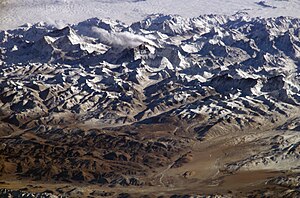
Back Himalaja Afrikaans Himalaya ALS ሂማላያ ተራሮች Amharic Himalaya AN हिमालय ANP هملايا Arabic هيمالايا ARZ হিমালয় Assamese Himalaya AST Гьималаял AV




The Himalayas are a mountain range in South Asia.
The west end of the mountain range is in Pakistan. They run through Jammu and Kashmir, Himachal Pradesh, Uttarakhand, Sikkim and Arunachal Pradesh states in India, Nepal, and Bhutan. The east end is in the south of Tibet. They are divided into 3 parts: Himadri, Himachal and Shiwaliks.
The 15 highest mountains in the world are in the Himalayas. The main ones are Mount Everest, Annapurna, and Nanga Parbat. Mount Everest is the highest mountain on Earth, at 8,849 meters. Mount Kanchenjunga 8,586 m (28,169 ft), the third highest mountain in the world also lies in Himalaya Range. [1]Of the fifteen highest mountain peaks in the World, nine are in the Nepali Himalayas.
The word "Himalaya" means House of Snow in Sanskrit, an old south asian language. North of the Himalayas is the Tibetan Plateau. It is called "the roof of the world". However, the Tibetan Plateau is very dry both because of its high elevation and the mountains acting to make a gigantic rain shadow. The rain, coming from the south, falls on the south side of the mountains. This has greatly influenced the climate of the Indian subcontinent. Not only do the mountains block the extremely cold winter winds blowing from Central Asia from entering the Subcontinent, they also forces the Bay of Bengal Monsoon branch to shed its moisture along NE and Northern Indian States, Bhutan, Nepal and Bangladesh.
- ↑ Nepalaya, Treks. "Himalayas".